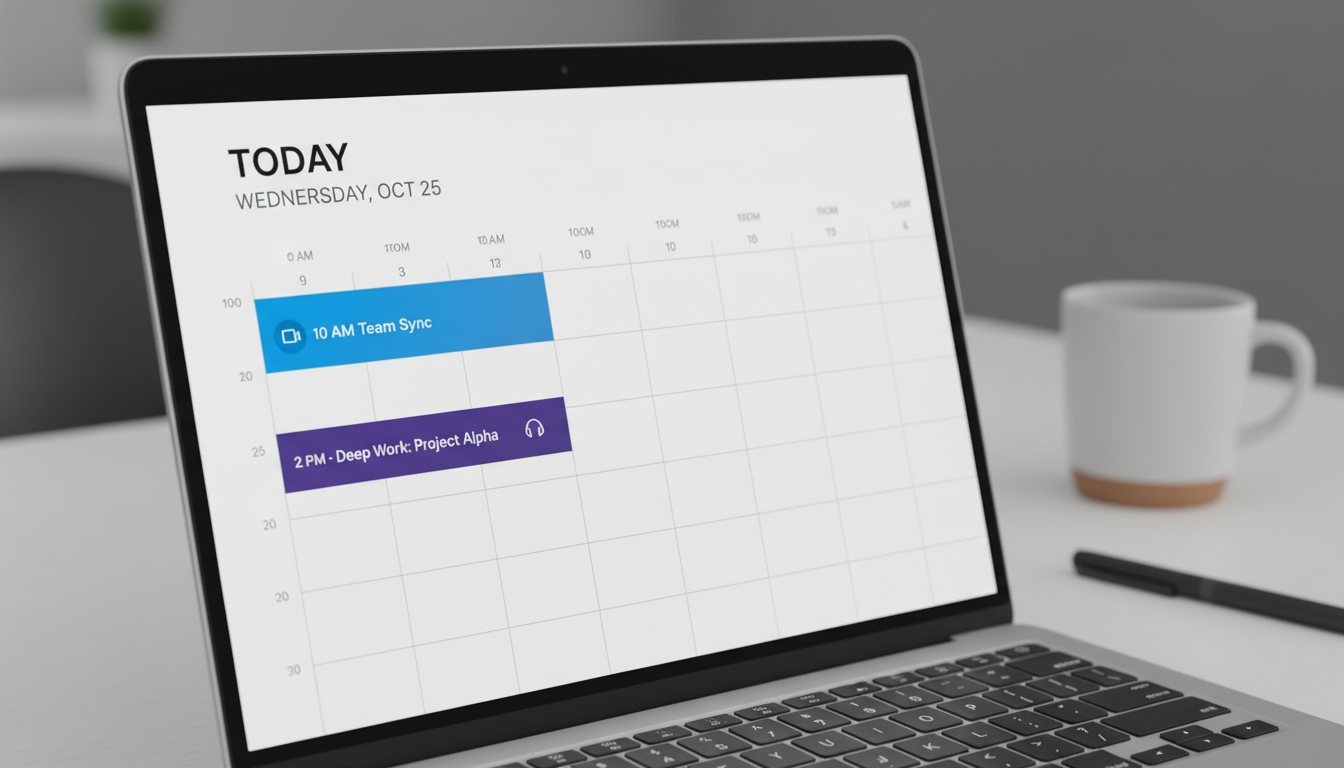
Productivity isn’t about heroic, white-knuckled effort. It’s not about finding more hours in the day or sacrificing sleep for a few extra tasks. That’s a recipe for burnout, a fast track to feeling overwhelmed and perpetually behind. The real secret to sustainable high performance lies in building small, reliable systems that do the heavy lifting for you. This is the core principle behind one of the most enduring productivity frameworks: the Getting Things Done method, or GTD.
Forget the myth of the flawless, hyper-organized superhuman. The most productive people you know aren’t necessarily smarter or more disciplined; they have simply offloaded the mental burden of remembering everything onto a trusted, external system. Their minds are free from the clutter of “don’t forget to…” and “I need to deal with…” This mental clarity allows them to focus entirely on the task at hand, whether that’s writing a complex report, strategizing with their team, or being fully present with their family.
David Allen, the creator of the GTD system, famously described the human brain as being for having ideas, not holding them. Every “open loop”—every unfinished task, unmet promise, or unresolved issue—occupies a slice of your cognitive RAM. The more loops you have open, the slower your mental processing becomes. You feel stressed, distracted, and incapable of deep work. The GTD system explained simply is a five-step process to close these loops, clearing your mental workspace so you can think, create, and execute with precision.
This guide will demystify the Getting Things Done method. We won’t just talk theory. We will give you practical, low-friction techniques you can implement today to reclaim your focus and build a sustainable task management system that works for you, not against you.
📚 Table of Contents
- The Five Core Pillars of the GTD System
- 1. Capture: Corral Your “Stuff”
- 2. Clarify: Process What It Means
- 3. Organize: Put It Where It Belongs
- 4. Reflect: Review and Keep It Fresh
- 5. Engage: Do the Work with Confidence
- Low-Friction GTD Hacks You Can Start in Minutes
- The One-Screen Phone Reset
- The 10-Minute Desk Reset
- The 15-Minute “Mini” Weekly Review
- The 60-Minute Time Audit Snippet
- Essential Tooling for a Frictionless GTD System
- Your Calendar: The Hard Landscape
- Timers: Your Focus Companion
- Shortcuts and Automation: Reducing Cognitive Load
- Compounding Habits: From Micro-Wins to a Macro System
- The GTD System in Action: Two Worked Examples
- Frequently Asked Questions About the GTD System
- Is the secret in the tool or the habit?
- What are the switching costs of adopting the GTD method?
- How long should I try a new hack before deciding it’s not for me?
- When is it time to quit a system or a tool?
- Is GTD suitable for creative or non-structured work?
- Conclusion: Three Actions to Start Today

The Five Core Pillars of the GTD System
Before we dive into specific hacks, it’s essential to understand the engine that drives the entire GTD framework. This isn’t just a collection of tips; it’s a holistic workflow designed to process the chaos of your life into an organized, actionable inventory. The gtd system is built on five sequential stages.

1. Capture: Corral Your “Stuff”
The first step is to get everything out of your head. Every idea, task, reminder, and commitment—no matter how big or small—must be captured in a trusted collection tool. This could be a physical inbox, a digital notebook, a voice memo app, or an email to yourself. The tool doesn’t matter as much as the habit. The goal is 100% capture. If you trust that everything is being collected, your mind can finally let go of the responsibility of remembering it all.

2. Clarify: Process What It Means
Once you’ve captured your “stuff,” you must process it. This is not about doing the work; it’s about deciding what the work is. For each item in your inbox, you ask a series of simple questions. First and foremost: is it actionable? If the answer is no, you have three choices: trash it, file it as reference material, or put it on a “Someday/Maybe” list for later consideration. If it is actionable, you move to the next step.
A key rule here is the famous “Two-Minute Rule.” If an actionable item will take less than two minutes to complete, do it immediately. Replying to a quick email, making a fast phone call, or filing a document often takes less time to do right now than to organize and track for later. This simple habit prevents small tasks from piling up and creating a mountain of administrative debt.

3. Organize: Put It Where It Belongs
Once you’ve clarified an actionable item that takes more than two minutes, you need to organize it. This is where the GTD system’s power in task management truly shines. You don’t just create one long to-do list. Instead, you sort tasks into specific buckets. If it has a deadline, it goes on your calendar. If it’s a multi-step endeavor, it becomes a “Project,” and you identify the very next physical action required to move it forward. That “Next Action” then goes onto a context-based list, such as “@Calls,” “@Computer,” “@Errands,” or “@Home.” This way, when you have the time and tools for a certain context, you can see all relevant tasks at a glance.

4. Reflect: Review and Keep It Fresh
Your system is only as good as its last review. The fourth pillar is reflection, most commonly practiced as the “Weekly Review.” Once a week, you set aside time to look over all your lists, projects, and calendar entries. You clean up your inboxes, review your upcoming appointments, check on your project progress, and look at your “Someday/Maybe” list. This regular review ensures your system remains a current, accurate, and trusted reflection of your commitments. It’s the essential maintenance that prevents the entire structure from collapsing back into chaos.

5. Engage: Do the Work with Confidence
With a clear, organized, and current system, you can finally engage with your work without distraction or doubt. You can trust that you are working on the right thing at the right time because you’ve already done the hard thinking during the Clarify, Organize, and Reflect stages. When you sit down to work, you can simply consult your context lists and choose what to do based on your available time, energy level, and priority. This is the ultimate payoff of the Getting Things Done method: a state of “mind like water,” where you can respond to whatever comes your way with appropriate force and focus.

Low-Friction GTD Hacks You Can Start in Minutes
Understanding the theory is one thing; putting it into practice is another. The beauty of the GTD system is that you don’t need to implement the entire framework overnight. You can start with small, high-impact habits that deliver immediate wins. Here are a few practical hacks that embody the GTD spirit and take less than 15 minutes to set up.

The One-Screen Phone Reset
Your phone is a primary inbox but also a primary source of distraction. Tame it with a simple organization tweak. The goal is to turn your phone from a reactive slot machine into a deliberate tool. Move all your apps off your main home screen, except for the absolute essentials—perhaps your phone, messages, camera, and a primary capture tool like a notes app. Place every other app into a single folder on your second screen. Now, to open an app like social media or a game, you have to consciously swipe, open the folder, and find it. This tiny bit of friction is often enough to break the cycle of mindless scrolling and reinforces the “Capture” and “Engage” principles by making your primary tool more focused.

The 10-Minute Desk Reset
Your physical environment dramatically impacts your mental state. A cluttered desk is a visual to-do list, a constant reminder of open loops. At the end of each workday, set a timer for 10 minutes and perform a “desk reset.” This is a miniature version of the GTD “Clarify” and “Organize” steps. Put away papers, file documents, wipe down the surface, and arrange your essential tools (pen, notebook, keyboard) for the next day. This simple ritual closes the day’s work and presents your future self with a clean, inviting workspace, ready for focused engagement.

The 15-Minute “Mini” Weekly Review
A full Weekly Review can feel intimidating at first. Start with a bite-sized version. Block out 15 minutes on your Friday afternoon calendar. During this time, do only three things. First, process all your inboxes (email, physical tray, notes app) to zero. Second, look at your calendar for the next seven days to understand your “hard landscape”—the appointments and deadlines you can’t move. Third, write down the one to three most important things you want to accomplish next week. This “1-3-5 rule” (one big thing, three medium things, five small things) is a great way to prioritize. This mini-review ensures no urgent tasks fall through the cracks and sets you up for a proactive, intentional week ahead, embodying the “Reflect” pillar of GTD.

The 60-Minute Time Audit Snippet
Most of us have a distorted perception of where our time actually goes. To improve your productivity, you first need a baseline. You don’t need to track every minute of every day. Just perform a “time audit” for a single 60-minute block during your workday. Open a simple text file or a notebook page. For one hour, every time you switch tasks, write down the time and what you’re working on. The results will be shocking. You’ll see how often you get pulled away by notifications or self-interrupt. This exercise highlights the friction of context-switching and powerfully demonstrates the need for techniques like batching, where you group similar tasks (like answering emails) into a single, uninterrupted block of time.

Essential Tooling for a Frictionless GTD System
While the Getting Things Done method is tool-agnostic, the right tools, used correctly, can significantly reduce the friction of implementing the system. The goal is not to find the perfect, all-in-one app, but to assemble a simple, reliable toolkit that supports the five core pillars. Here are the non-negotiable components and how to use them effectively.

Your Calendar: The Hard Landscape
Your calendar is sacred ground. It should be reserved for only three things: time-specific appointments (a 10 AM meeting), day-specific information (a colleague is out of office), and commitments of time to yourself (a 90-minute block for deep work). It is not a to-do list. Placing aspirational tasks on your calendar is a recipe for failure. When an urgent issue arises, you’re forced to “reschedule” your to-do, creating a sense of failure and cluttering your view. Keep your calendar clean. It represents your “hard landscape,” the appointments around which your flexible “Next Actions” will flow. This clarity is fundamental to effective task management.

Timers: Your Focus Companion
The human mind wanders. A simple timer is one of the most powerful tools for bringing it back. This is the principle behind techniques like the Pomodoro Technique, but you can apply it more broadly. The practice of timeboxing—allocating a fixed time period to a specific task—creates a sense of urgency and a defined finish line. Want to clear your email inbox? Set a 25-minute timer and work on nothing else. Need to brainstorm a project? Set a 45-minute timer and just think. Using a physical timer or a simple app on your computer creates an audible and visual cue that you are in a state of focused work. It trains your brain to associate the ticking clock with deep engagement, a core tenet of the final GTD stage.

Shortcuts and Automation: Reducing Cognitive Load
Every click, every keystroke, every moment spent searching for a file is a tiny bit of friction. Multiplied over hundreds of interactions a day, this friction adds up to significant cognitive load and wasted time. Invest a few hours in learning the keyboard shortcuts for your most-used applications. Learn how to set up simple automations, like email filters that automatically sort newsletters out of your primary inbox. Use a text expansion tool to save yourself from typing the same phrases over and over. Each small optimization you make is a deposit in your focus bank, freeing up mental energy that can be better spent on high-value creative and strategic work. This supports the “Organize” and “Engage” steps by making the mechanics of your workflow nearly invisible.

Compounding Habits: From Micro-Wins to a Macro System
Individual hacks are powerful, but their true potential is unlocked when you begin to chain them together. The GTD system is not just a series of disconnected actions; it’s an interconnected workflow where each step supports the next. This compounding effect is where you transition from simply “trying a productivity tip” to truly living a more organized and focused life.
Consider the relationship between the desk reset and a focused work block. A 10-minute desk reset at 5 PM isn’t just about tidiness. It’s an act of kindness to your future self. When you arrive the next morning, you aren’t met with the chaotic remnants of yesterday. You’re greeted by a clean, prepared workspace. This lack of visual clutter removes a significant psychological barrier to starting your most important task. You can seamlessly transition into a timeboxing session for 90 minutes of deep work, because you’ve already handled the “stuff” that would otherwise be vying for your attention. The small habit enables the larger, more valuable one.
Similarly, the “Mini” Weekly Review feeds directly into your daily execution. When you take 15 minutes on Friday to clarify your top priorities for the coming week, you eliminate the dreaded “What should I work on now?” paralysis on Monday morning. You can sit down, consult the short, prioritized list you already made, and engage immediately with meaningful work. This proactive planning, a core part of the “Reflect” stage, prevents the tyranny of the urgent from hijacking your week.

A Word of Caution: Guard Against Over-Optimization
As you begin to experience the benefits of these systems, it can be tempting to fall into the trap of over-optimization. You might start spending more time tweaking your task management app than actually doing the tasks. You might design the “perfect” workflow that is so rigid and complex it shatters the moment an unexpected meeting appears on your calendar.
Remember, the goal of the Getting Things Done method is to create clarity and reduce stress, not to add a new layer of complex administration to your life. Your system should be “just good enough.” It needs to be robust enough to handle the complexity of your life but flexible enough to adapt to reality. If a part of your system feels brittle or causes more friction than it removes, simplify it or discard it. The map is not the territory, and your productivity system is not the work itself. It is merely a tool to help you do the work that matters.

The GTD System in Action: Two Worked Examples
Theory and hacks are useful, but seeing how the gtd system adapts to real-world scenarios makes it tangible. Let’s explore how two very different professionals might apply these principles.

Manager Maria: Juggling Meetings and a Team
Maria is a department head whose calendar is a wall of back-to-back meetings. Her biggest challenge is reactive work—urgent emails, team questions, and unexpected problems. Her goal is to carve out space for strategic thinking while staying responsive to her team.
Capture: Maria uses a combination of tools. Emails stay in her inbox as one capture point. She uses a digital notes app on her phone to quickly jot down thoughts or tasks that come up during meetings. She also keeps a physical notepad on her desk for anything that arises while she’s on a call. At least twice a day, she empties the notepad and app notes into her email inbox, creating one central place to process.
Clarify & Organize: Between meetings, Maria processes her inbox using the “Two-Minute Rule” aggressively. Quick replies are sent immediately. For larger tasks, she identifies the “Next Action.” If it’s something she needs to discuss with a specific team member, it goes on her “@Waiting For” list or on the agenda for her next one-on-one. If it’s a task for her, like “Draft the Q3 budget proposal,” the project is listed in her project list, and the next action, “Review last year’s Q3 budget numbers,” goes on her “@Computer” list.
Reflect & Engage: Maria’s Weekly Review is non-negotiable. It’s a 45-minute block in her calendar every Friday afternoon. This is her time to review her projects, follow up on “@Waiting For” items, and plan her priorities for the next week. During the week, she uses the 15-20 minute gaps between meetings to check her “@Computer” list and knock out a few quick, focused tasks. She has learned that trying to do deep strategic work in these small gaps is futile. Instead, she blocks out a 90-minute “No Meetings” focus block twice a week to work on her most important projects, like the budget proposal.

Solo Maker Sam: Structuring a Proactive Schedule
Sam is a freelance designer. He has very few meetings and his schedule is almost entirely his own. His biggest challenge is fighting procrastination and staying focused on long-term client projects without the external structure of a traditional office environment.
Capture: Sam uses a single digital to-do list app as his universal inbox. Any idea, client request, or personal task gets dumped there immediately via his phone or desktop app. This keeps his mind clear and focused on the creative task at hand.
Clarify & Organize: Once a day, at the end of his workday, Sam processes his inbox. He sorts tasks into projects (e.g., “Client X Website Redesign,” “Client Y Logo Package”). He then creates specific “Next Action” items for each, like “Create three initial wireframe concepts for Client X” or “Research competitor logos for Client Y.” These are tagged with contexts like “@Deep Work” or “@Admin.”
Reflect & Engage: Sam lives by timeboxing. He plans his day in large, 90-minute to 2-hour blocks. His calendar might say “9:00 AM – 11:00 AM: Work on Client X Wireframes.” During that block, he puts his phone in another room, closes all irrelevant tabs, and works only on that task. He uses a timer to enforce this focus. His Weekly Review on Friday is crucial for looking at his project pipeline, sending invoices (an “@Admin” batching task), and deciding which major project blocks to schedule for the following week. This structure provides the discipline he needs to make consistent progress on his creative work.

Frequently Asked Questions About the GTD System
Is the secret in the tool or the habit?
This is the most common question in productivity. While a good tool can reduce friction, the secret is unequivocally in the habit. A person with a simple pen and paper who consistently follows the five steps (Capture, Clarify, Organize, Reflect, Engage) will be far more effective than someone with the most expensive, feature-rich software who only uses it sporadically. The tool’s only job is to be trusted and easy to use. Focus 90% of your energy on building the habits, particularly the daily processing of your inbox and the non-negotiable Weekly Review.
What are the switching costs of adopting the GTD method?
The initial switching cost can feel high, which is why a “big bang” adoption is not recommended. The first time you do a full “Capture” sweep of your entire life and office, it can take several hours, and the initial processing can feel overwhelming. This is why starting small is key. Don’t try to implement the entire GTD system at once. Start with one hack, like the 10-minute desk reset. Once that’s a habit, add a 15-minute Weekly Review. After a few weeks, try processing your email inbox to zero every day. By gradually layering these habits, you minimize the disruption and build a sustainable practice over time.
How long should I try a new hack before deciding it’s not for me?
Give any new habit or technique at least two full weeks of consistent effort before making a judgment. The first few days will feel awkward and inefficient because you’re breaking old patterns and forging new neural pathways. It’s during the second week that you start to see the benefits and the process begins to feel more natural. If, after 14 days of genuine effort, a specific technique consistently adds more stress than it relieves, then it’s okay to discard it and try something else. The goal is to build a system that serves you, not to adhere dogmatically to a method that doesn’t fit your work style.
When is it time to quit a system or a tool?
You should consider quitting a tool or system when it starts to generate “meta-work”—that is, when you spend more time managing the system than doing the actual work. If you find yourself constantly reorganizing your tags, switching to new apps, or building complex, color-coded spreadsheets, that’s a red flag. A great task management system should feel almost invisible. It should be a quiet, reliable engine running in the background, not a high-maintenance machine that requires constant tinkering. When the system becomes the focus, you’ve lost the plot.
Is GTD suitable for creative or non-structured work?
Absolutely. In fact, it’s often more valuable for creative professionals. The structure of the Getting Things Done method is not about rigidly scheduling every minute of your day. It’s about clearing your mind of administrative clutter so that you have more mental bandwidth available for creativity and deep thinking. By getting all the “I need to…” and “Don’t forget…” items out of your head and into a trusted system, you create the psychological space necessary for innovation and inspiration to flourish.
Disclaimer: The information provided in this article is for educational and informational purposes only and is not intended as medical, financial, or legal advice. For more on the science behind focus and well-being, you may wish to consult resources like the American Psychological Association, the National Institutes of Health, or the Sleep Foundation.

Conclusion: Three Actions to Start Today
The journey to mastering the GTD system is a marathon, not a sprint. The goal is not to achieve perfection overnight but to make small, incremental progress every day. Overwhelm is the enemy of action, so we’re going to close with three simple, concrete steps you can take right now to begin reclaiming your focus and building a more intentional life.
1. Capture One Open Loop. Think of one thing that’s been nagging at you. It could be a task, an idea, or a worry. Don’t do it. Just get it out of your head. Write it down on a piece of paper, in a new note on your phone, or send yourself an email with the subject line “Process.” Feel the small sense of relief that comes from knowing it’s captured and you no longer have to actively remember it. This is the first step toward building a trusted capture habit.
2. Set a Timer for 25 Minutes. Pick a single task that you’ve been procrastinating on. It doesn’t have to be the biggest or most important one. Set a timer for 25 minutes and work on that one thing exclusively. No email, no phone, no distractions. When the timer goes off, you can stop. This simple exercise demonstrates the power of focused, undistracted work and is the first step toward mastering the “Engage” pillar of the Getting Things Done method.
3. Schedule Your First Weekly Review. Open your calendar right now and block out 30 minutes for this coming Friday afternoon. Label it “Weekly Review.” You don’t need to know exactly what you’ll do yet. Just commit to the time. Protecting this sacred time for reflection is the single most important habit for maintaining a functional and trustworthy productivity system over the long term. This is your commitment to yourself and to a more organized future.
These small actions are the seeds from which a powerful and sustainable system grows. Start here, stay consistent, and you will be well on your way to getting the right things done with less stress and more clarity.






